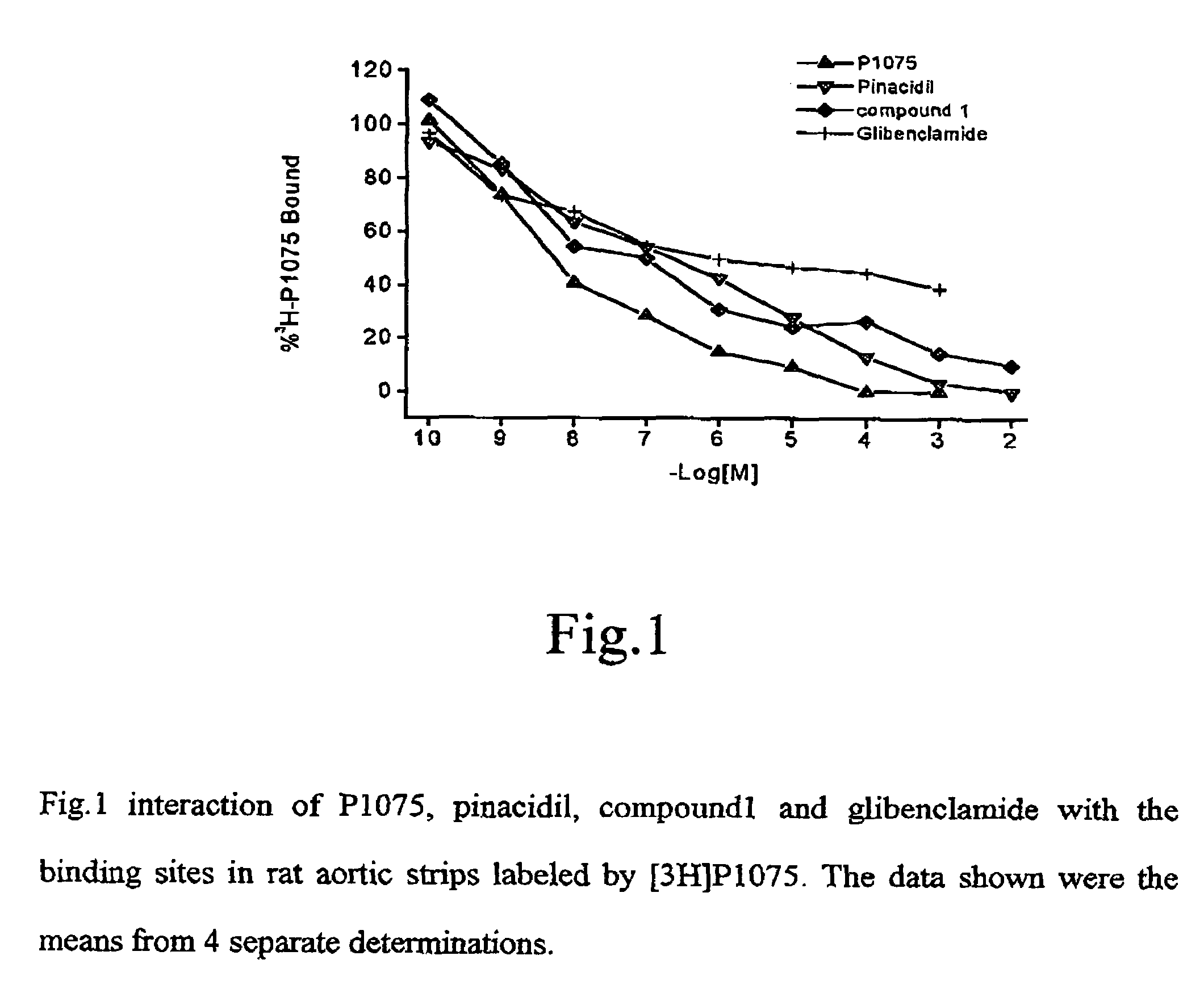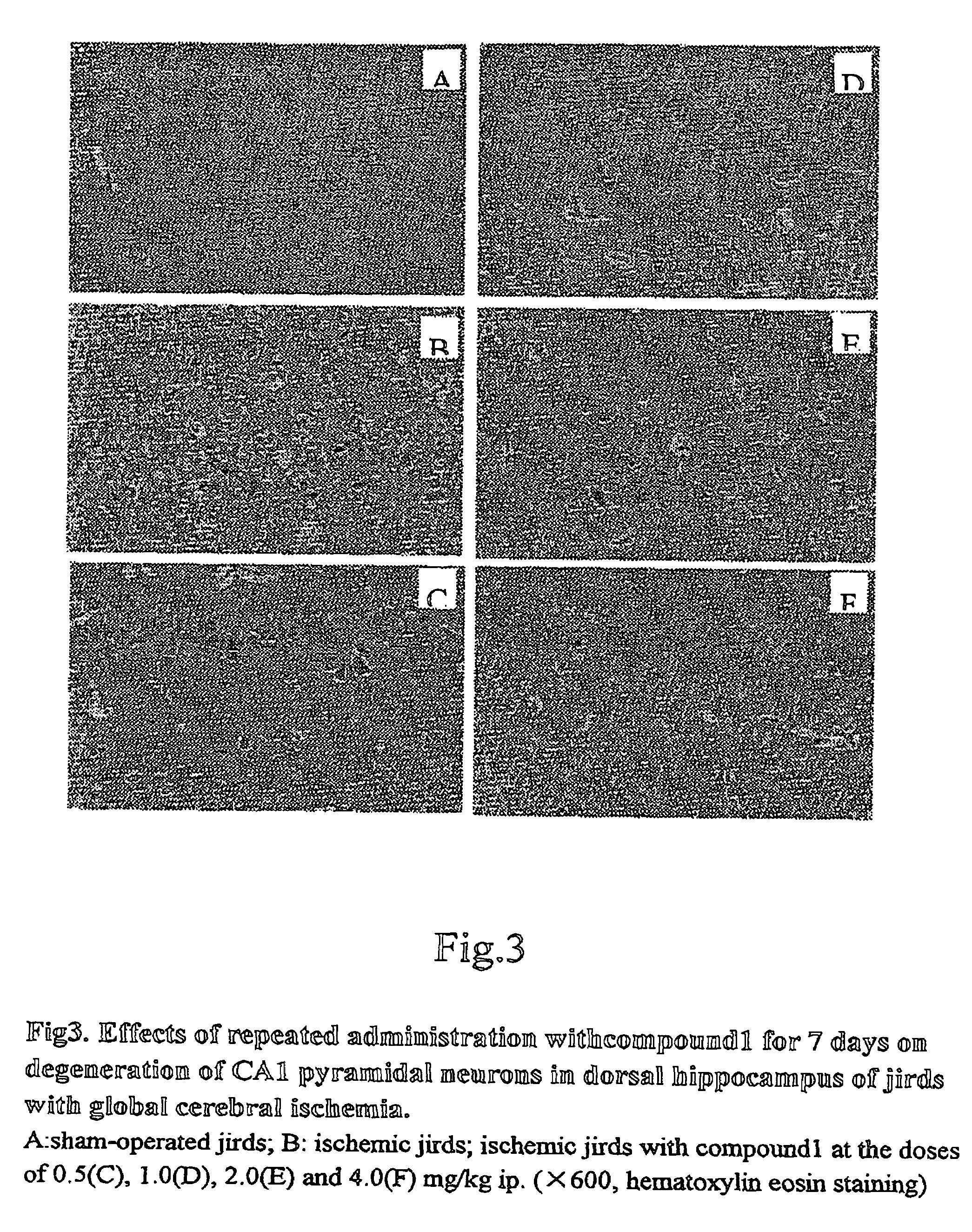Amine derivative with potassium channel regulatory function, its preparation and use
a potassium channel and potassium channel technology, applied in the field of amine derivatives, can solve the problems of edema, reflex tachycardia, edema, cardialgia,
- Summary
- Abstract
- Description
- Claims
- Application Information
AI Technical Summary
Problems solved by technology
Method used
Image
Examples
example 1
[0151]Production of N-(1-methylethyl)-2,3-dimethyl-2-butylamine (Compound 1): Method 1. The solution of 7.6 g (0.0745 mole) 2,3-dimethyl-2-butanol in 3.24 mL glacial acetic acid was cooled and maintained at −5 to −8 degree of centigrade (° C.), then was added 7.3 g (0.49 mole) of powdered potassium cyanide in several times under stirring. 32.4 mL concentrated sulfuric acid was added dropwise while keeping the temperatue below 20 ° C., after which, the reaction mixture was stirred for 3.5 hours below 20° C. and another 6 hours at room temperature, then stood overnight. After poured into ice colded water, the mixture was adjusted to pH10 with 20% aqueous sodium hydroxide solution, and extracted with ether (×4). The extract was dried over anhydrous sodium sulfate. After filtration on the next day, the dessicator was removed, and the filtrate was evaporated off the ether, then distilled in vacuum to give 8.8 g (yield 91.6%) N-[2-(2,3-dimethylbutyl)]-fomide; bp 105-108° C. / 5 mmHg.
[0152]T...
example 2
[0158]Preparation of N-propyl-2,3-dimethyl-2-butylamine (compound 5)
[0159]To a solution of 8.25 g (0.15 mole) propionitrile in 25 mL glacial acetic acid, 15 g concentrated sulfuric acid was added dropwise while controlling the reaction temperature at about 38° C., then 5.2 g (0.051 mole) of 2,3-dimethyl-2-butanol was added dropwise at the temperature below 40° C. with stirring. The mixture was stirred overnight while maintaining the temperature, then poured into glacial water, basified with 40% sodium hydroxide solution and extracted with ether. The ether extract was combined, washed once with water, and dried over anhydrous magnesium sulfate. After recovering the ether, 6.2 g light yellow liquid was obtained and solved in 80 mL anhydrous ether. The resulting solution was added dropwise to a suspension of 3.04 g (0.08 mol) lithium aluminium hydride in 80 mL anhydrous ether. The mixture was refluxed for 10 hours, then cooled. To the mixture, proper amount of 40% aqueous sodium hydrox...
example 3
[0160]Preparation of N-(1-methylpropyl)-2,3-dimethyl-2-butylamine (compound 13)
[0161]Similar treatment of 2,3-dimethyl-2-butylamine with bromoisobutane as example 1 gave compound 13 with a yield of 17.1%. The melting point (mp) of the hydrochloride is 203-204° C. Element analysis for C10H14NCl (%): Calculated C,61.99; H,12.49; N7.23. found C,62.17; H,13.18; N,7.27. MS (m / z) 157(M+); 1H-NMR(D2O, ppm) 0.90 (d, 6H), 1.18(t, 3H), 1.26(d, 3H), 1.28-3.43(m, 19H).
PUM
| Property | Measurement | Unit |
|---|---|---|
| pressure | aaaaa | aaaaa |
| pressure | aaaaa | aaaaa |
| temperature | aaaaa | aaaaa |
Abstract
Description
Claims
Application Information
 Login to View More
Login to View More - R&D
- Intellectual Property
- Life Sciences
- Materials
- Tech Scout
- Unparalleled Data Quality
- Higher Quality Content
- 60% Fewer Hallucinations
Browse by: Latest US Patents, China's latest patents, Technical Efficacy Thesaurus, Application Domain, Technology Topic, Popular Technical Reports.
© 2025 PatSnap. All rights reserved.Legal|Privacy policy|Modern Slavery Act Transparency Statement|Sitemap|About US| Contact US: help@patsnap.com



